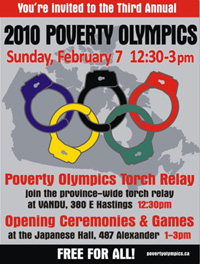World Class Poverty
Canada is one of the wealthiest countries in the world. And the province of British Columbia (BC) is among its most prosperous regions. But some people are being left behind.
Vancouver’s Downtown Eastside — the city’s poorest neighbourhood — was singled out in 2007 by the United Nations Population Fund as a sign of “trouble in paradise.” The HIV rate here is 30% — the same as Botswana’s. Other diseases like Hepatitis C are rampant. Visitors who think of Canada as a caring, wealthy place are shocked to see the malnutrition, addiction, homelessness, and other harsh signs of grinding poverty all around.
It’s not just one “problem” neighbourhood either. British Columbia has the highest poverty rate in the country. One in five BC children live in poverty.
There are about 10,000 homeless people in communities all around our province, even in small towns. More than 2,000 of them live on the streets of Greater Vancouver. Pivot Legal Society estimates that homelessness in Vancouver is likely to triple by 2010.
Making things worse, not building an Olympic legacy
Poverty isn’t new, but things weren’t always this bad. Until 2001, poverty in British Columbia was dropping faster and farther than the national (across-Canada) rate.
So what changed?
Between 2002 and 2005, the BC government cut spending on social programs by nearly one third. That included an end to annual funding for new social housing.
The BC government also made social assistance (welfare) much, much harder to get. It forced people to jump through a maze of bureaucratic hoops, such as making anybody seeking help go through a complicated computer-based application (even advocates had a heck of a time figuring it out). It forced people who could no longer pay rent or buy food to wait three weeks before even letting them apply for help.
During those years, the number of people getting welfare dropped steeply — and the number of homeless people in Greater Vancouver doubled.
The BC Government also cut welfare benefits for single parents and their children, and for older folks. Poverty rates among single parents jumped as a result.
All this happened at the very time when big promises were being made to win the 2010 Olympics bid — promises to build more social housing, reduce homelessness, and make sure poor people weren’t displaced by Olympics-driven development.
Bad decisions have made poverty and homelessness worse. Some small steps have been taken recently to change course, but more must be done.
Read on for solutions and help us make change.
| Average income for poor BC parents is over $11,000 BELOW the poverty line
BC poverty rate for aboriginal children: more than 40% BC poverty rate for children in single parent families: 50% Average annual income fore richest one tenth of 1% in BC: almost $2.5 million Welfare rate for single so-called employable people in BC as a percent of the poverty line: 34.5% Source: 2008 BC Campaign 2000 Child Poverty Report Card, November 2008 |

Source: Statistics Canada, Income Trends in Canada 1976 to 2007 (using low-income cut-offs before taxes) via First Call: BC Child and Youth Advocacy Coalition.
– – – – –
More information/Links:
5 Facts About Poverty in BC/11 Facts About Poverty in Canada
Prepared by Raise the Rates, February 2010
Downtown Eastside fact sheet
Prepared by the Carnegie Community Action Project (CCAP), January 2010
Article: Prosperity and poverty make for uneasy bedfellows in world’s most ‘livable’ city
by Patricia Leidl, UN Population Fund
Homelessness in Vancouver could triple by 2010, CBC News
Study finds BC’s welfare system denying assistance to people in need, ‘diverting’ many to homelessness and hardship, Canadian Centre for Policy Alternatives
2005 and 2008 Metro Vancouver Homeless Counts
Budget Savings on the Backs of the Poor, Canadian Centre for Policy Alternatives
Bucking the National Trend: BC’s welfare cuts and poverty among lone mothers, by Jane Pulkingham
Homelessness in Vancouver – Citywide Housing Coalition
